We have been promoting a wide range of R&D activities by systematically coordinating the R&D Directorates for each of the research themes which have been described in the previous chapters, and R&D Centers in 12 locations throughout Japan.
The R&D Directorates of JAEA are promoting R&D for their respective purposes with experimental equipment/facilities at relevant R&D Centers. The R&D Centers have not only been operating and managing various types of equipment/facilities but have also been working on innovations and improvements for them, and in addition have themselves been developing experimental techniques, management techniques and equipment/facilities necessary for the various R&D projects of JAEA.
This chapter introduces the developments which have been made recently at each R&D center.
Tsuruga Head OfficeThe Entire System Function Test (ESFT) of "MONJU" was completed in August 2009, after overcoming troubles found in 2008 including false alarms by sodium leak detectors and corrosion holes in an outdoor exhaust duct. At present, repairs and inspection are being carried out in order to begin the System Start-up Test (SST) in fiscal year 2009. "FUGEN" was reorganized from the Fugen Nuclear Power Station into the Fugen Decommissioning Engineering Center after the approval of a decommissioning plan in February 2008. This Center aims to incorporate useful innovations in decommissioning projects, and is currently dismantling facilities and equipment with relatively low-level radiation or without contamination. The Center also collects and ships out heavy water in accordance with careful plans. |
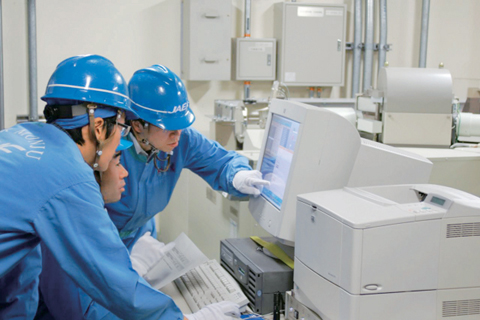 Confirmation of data from the fuel damage detector during the ESFT |
Tokai Research and Development Center, Nuclear Science Research Institute (NSRI)NSRI has safely and successfully operated research reactors, accelerators, criticality testing facilities, nuclear fuel handling facilities, and post-irradiation testing facilities (hot laboratories), which are used for various kinds of nuclear research. The Facility of Radiation Standards (FRS), one of the largest calibration facilities in Asia, is equipped with reliable devices for calibrating detectors of radiation and radioactivity. FRS is used for calibration and performance tests of radiation measuring instruments for radiation protection, such as survey meters, installed monitors, and personal dosimeters, used in nuclear facilities. Calibration fields of mono-energetic neutrons using a 4MV Van-de-Graaff accelerator and of high-energy γ-rays are being developed and R&D on dosimetry is being carried out, to contribute to radiation protection in large accelerator facilities such as J-PARC (Topic 14-2). |
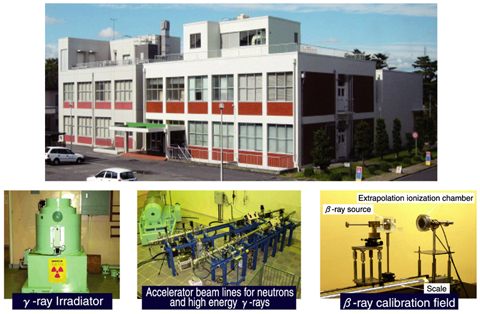 This Picture(347KB) Outside view and calibration devices of Facility for Radiation Standards |
Tokai Research and Development Center, Nuclear Fuel Cycle Engineering LaboratoriesAt the Plutonium Fuel Development Center, an engineering scale test for an advanced FBR fuel fabrication method named the "Simplified Pellet Fabrication Process" is being carried out. The obtained pellets satisfy specifications of the "MONJU" fuel, are used as fuel for "MONJU". Various other R&D are being executed, for technology such as advanced reprocessing by an aqueous method and by a pyrochemical method, and low level rad-waste treatment methods. At the Reprocessing Technology Development Center, evaluation of the seismic safety of Tokai Reprocessing Plant is being carried out. |
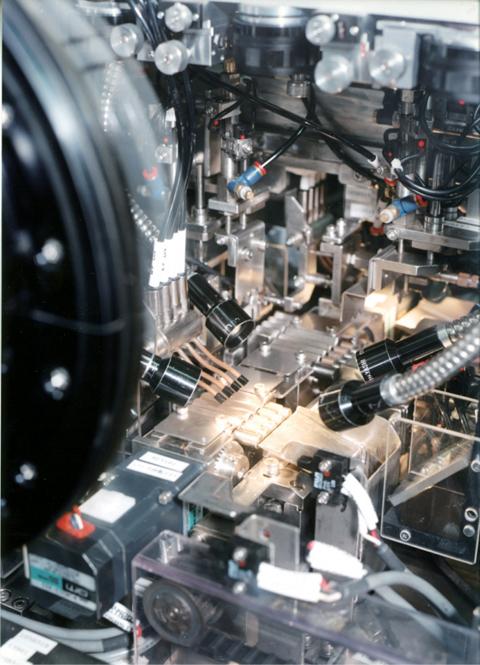 Mixed oxide fuel pellet inspection by remote control automated equipment |
J-PARC CenterConstruction has been completed for facilities defined as Phase-I of the J-PARC project in 2009. In the last fiscal year of 2008, on-beam tests of 3GeV synchrotron was conducted to achieve a stable operation increasing beam current with a stable beam injection from the linear accelerator. In May, 2008, beams were successfully injected to both the Materials & Life Experimental Facility (MLF), and the 50GeV synchrotron. Beam operation with more than 100kW power was demonstrated in December, 2008. The 100kW power was one year early achievement of the milestone we have set as the goal during the intermediate term of research framework. In MLF, a high performance of pulse neutron source was assured in terms of neutron intensity and pulse resolution. Since December 2008, we have started a user operation with six neutron instruments and one muon port. |
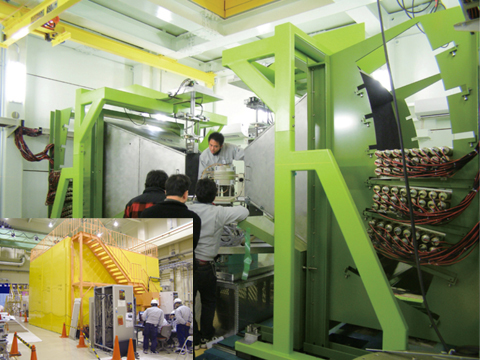 Engineering Materials Diffractometer TAKUMI (BL19, MLF)
|
Oarai Research and Development CenterOne of the experiments needed in the Fast Reactor Cycle Technology Development Project "FaCT", the post irradiation examination of FBR high burn-up fuel and minor actinide-containing fuel, was conducted. Experimental research at water and sodium test facilities was also carried out. The investigation of the cause of the trouble of the obstacle on the in-vessel storage rack in the experimental fast reactor JOYO (occurring in November 2007) and development of a strategy for prevention of this problem continued. The refurbishment of the Japan Materials Testing Reactor (JMTR) for restart in JFY2011 progressed, and JMTR held the 1st International Symposium on Material Testing Reactors from July 16 to 17, 2008. The High Temperature engineering Test Reactor (HTTR) had its annual inspection, and preparations for 50 days of HTTR full power operation with 950°C outlet coolant temperature in JFY2009 proceeded. |
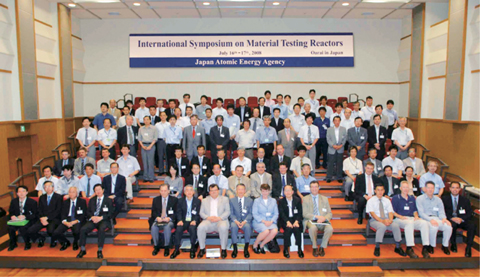 Commemorative photograph of the "1st International Symposium on Material Testing Reactors" attendees (July 17, 2008) |
Naka Fusion InstituteTowards the goal of creating "a sun on Earth", Naka Fusion Institute has been promoting research and development for the realization of fusion energy together with the Fusion Research and Development Directorate. In August 2008, the JT-60, the tokamak device in Naka Fusion Institute, completed its experimental operation, which had continued for 23 years since its first plasma in April 1985. On the other hand, the Satellite Tokamak JT-60SA (Super Advanced) Programme has been commenced in cooperation with EURATOM based on the Broader Approach Agreement, under which the JT-60 is being upgraded, for the purpose of providing support and supplemental research for the International Thermonuclear Experimental Reactor (ITER), as well as conducting research in core plasma and reactor engineering. As part of this Programme, 2 buildings for the manufacturing of JT-60SA superconducting coils (Superconducting Twisted Strands Jacketing Building and Superconductor Winding Building) were completed in March 2009. With this and other developments, this Programme is progressing to its next stage. |
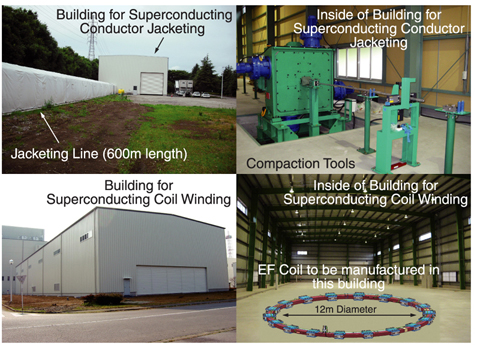 This Picture(505KB) Superconducting Strands Jacketing Building and Superconductor Winding Building and their interiors |
Takasaki Advanced Radiation Research InstituteThe four ion accelerators so-called Takasaki Ion Accelerators for Advanced Radiation Application (TIARA), the electron accelerator, and the gamma irradiation facilities at Takasaki Advanced Radiation Research Institute can be used both by researchers in JAEA and in other organizations to perform R&D on new functional and environment-friendly materials, biotechnology, radiation resistance of materials, or quantum beam analysis. Development of three dimensional in-air PIXE analysis technology (Topic 14-10), three dimensional microbeam writing technology, and technology for uniform wide area irradiation by a cyclotron is in progress. In fiscal 2008, fast single-ion hits of heavy ion micro beams of several hundred MeV at a rate of 1,500 hits per min or more were achieved by the cyclotron, which allow to start studies such as evaluation of radiation resistance of semiconductors and evaluation of effects of radiation on living cells. |
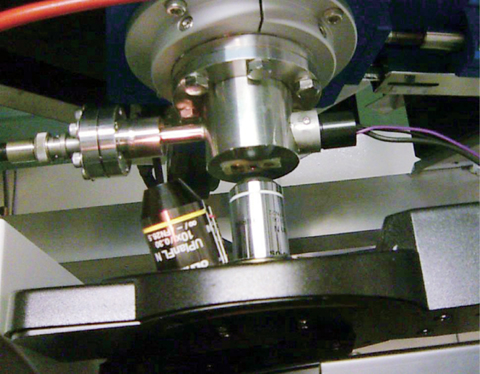 Extraction window for a micro ion beam from the cyclotron (upper portion) and a part of the microscope to observe ion-irradiation sample position (lower portion) |
Kansai Photon Science InstituteAt our facility in the Kizu district outside Osaka, we are making improvements in advanced lasers, such as improved beam quality of high-energy lasers and increased repetition rate of an X-ray laser, and are using these lasers for various research projects. Also, the Photo-Medical Research Center is promoting a project to create a "Photo-medical Industrial Valley", which was included in the "Formation of Bases for Innovation by Integrating Frontiers of Research" program adopted by the Ministry of Education, Culture, Sports, Science and Technology (MEXT) of Japan in 2007 and funded by the Special Coordination Funds for Promoting Science and Technology. (Topic Chapter 11: Photo-Medical Research Cooperation) Another new project "Consortium for Photon Science and Technology (C-PhoST)", which had been proposed in the scheme of "Photon Frontier network", consisting of universities and institutes (including JAEA) for pioneering photon research, was established in fiscal 2008. The Center for Photon Science and Technology was set up in August as the core institute of this consortium. In the Harima area near Himeji, we carry out various material science research projects, for example, a study on superconductivity of uranium compounds, using synchrotron radiation from SPring-8. In addition, JAEA provides four beamlines in SPring-8 not only for in-house but also outside researchers. |
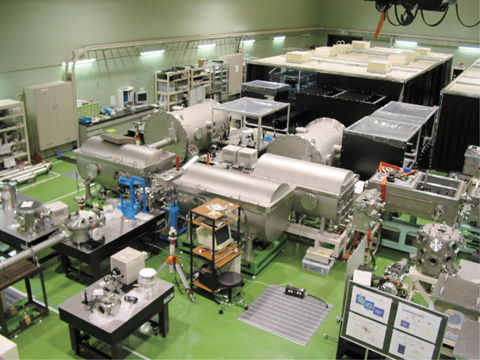 Plasma X-ray Laser apparatus |
Horonobe Underground Research CenterAs part of our research and development for geological disposal of high-level radioactive waste (HLW), the Horonobe Underground Research Center, a division of the Japan Atomic Energy Agency (JAEA), is implementing the Horonobe Underground Research Laboratory Project (Horonobe URL Project). The ventilation shaft and the east shaft were excavated to depths of 250m and 140m, respectively, and horizontal tunnels were excavated at the bottoms of these shafts. The waste water drainage facility to deal with underground water entering new excavations was expanded. Construction of an international exchange facility allowing interaction with researchers all around the world and with residents in Horonobe town was started, and this will be opened in October, 2009. Next year, excavation of the east shaft to the depth of 200m and of a new tunnel at 140m, and surveys to aid in underground water control will be carried out. |
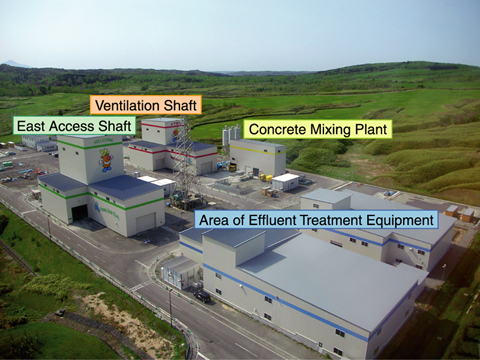 This Picture(511KB) Current Underground Facilities |
Tono Geoscience Center (TGC)TGC's task is to provide the scientific and technical basis for safe geological disposal of high-level radioactive waste. This involves research on long-term stability of the geological environment, and researches on development and improvement of techniques for characterization of deep geological environment and a wide range of engineering for deep underground application at an underground research laboratory in crystalline rock, referred to as the "Mizunami Underground Research Laboratory (MIU)". As of March 2009, the Main and Ventilation Shafts had reached depths of 300.2m and 331.2m, respectively. A horizontal tunnels of Measurement Niche off Ventilation Shaft (about 20m long) and an Access/Research Gallery (about 100m long) were excavated at a depth of 300m Stage (Topic 14-11). |
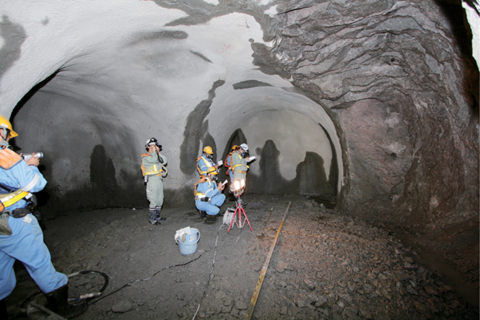 Geological mapping at "-300m Access / Research Gallery" |
Ningyo-toge Environmental Engineering CenterThe Ningyo Toge Environmental Engineering Center has been developing the nuclear material measurement apparatus "Ningyo Waste Assay System (NWAS)" to be used in safeguard measures and nuclear material management. During the decommissioning of a refining and conversion facility, this system will be tested. Because dismantling this refining and conversion facility will generate a large amount of waste and construction material contaminated with uranium, very quick measurement is needed. NWAS carries out neutron and the gamma-ray measurements simultaneously, and an estimation method comparing these measurements is adopted, allowing quick detection of even small amounts of uranium. Moreover, NWAS is portable, allowing measurement of dismantled materials at each place in the facility. |
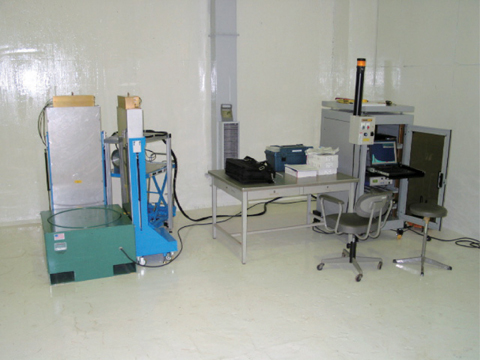 NWAS "Ningyo Waste Assay System" |
Aomori Research and Development CenterIn the Rokkasho area in Aomori Prefecture this March, the Administration & Research Building of the International Fusion Energy Research Center was opened for activities relating to the "Agreement for the Joint Implementation of the Broader Approach (BA) in the Field of Fusion Energy Research" between the government of Japan and the European Atomic Energy Community. The construction of three other buildings for the Center is expected to be completed by the end of next March. In the Mutsu area of Aomori, a radioactivity database for a clearance evaluation system is being compiled and a practical decommissioning method is being considered for the decommissioning of the nuclear ship "Mutsu" reactor facility. Also, technology for ultra low level measurement of C-14 and I-129 using an accelerator mass spectrometer (AMS) are being developed, and measurements are being done. |
 Photograph of the participants in the opening ceremony for the Administration & Research Building of the International Fusion Energy Research Center. (30th March, 2009) |